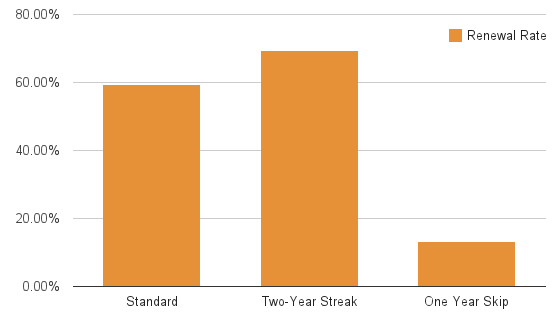
Trends
The cost-to-acquire vs cost-to-retain is a common question in marketing circles. Season passholders often find themselves at the center of that discussion for winter resorts. So, how likely is someone to buy a season pass when they skip a season compared to those that don’t? That was our question, here is our answer.
The Goods
We analyzed over 175,000 season passholders from just under twenty resorts and/or seasons. First, we started with a group of all the skiers who purchased a season pass in Season 1. Then, we created two groups: the group that DID renew in Season 2 and the group that DID NOT renew in Season 2. From there, we found the percentage of each group that bought a season pass in Season 3.
The three numbers below represent the typical renewal rate for skiers at the resorts in the sample (“Standard” below), the renewal rate in Season 3 of those that bought a pass in both Season 1 and Season 2 (“Two-Year Streak” below), and finally the pass purchase rate in Season 3 of skiers that bought a pass in Season 1 but DID NOT buy a pass in Season 2 (“One-Year Skip” below).

To put some more exact numbers behind the chart, the renewal rate of all skiers in the sample was 59.5%. The renewal rate of a skier with at least a two-year streak going was 69.5%. And the renewal rate for skiers that skipped a year was 13.3%.
In other words, a skier is over 5x as likely to buy a pass this year if they bought a pass the last two years rather than two years ago but not last year.
What This Means
A deeper analysis of this might be to segment those “skippers” by their transactions during the year they didn’t have a pass, but the clear takeaway today is this: a skier who renews is much, much easier to get back than a skier who lapses.
You should certainly market to lapsed passholders, but special attention should be paid long before the season is over to get current passholders primed and ready to renew when passes go on sale. It’s either that or an uphill, likely expensive, battle to get them back once they leave.